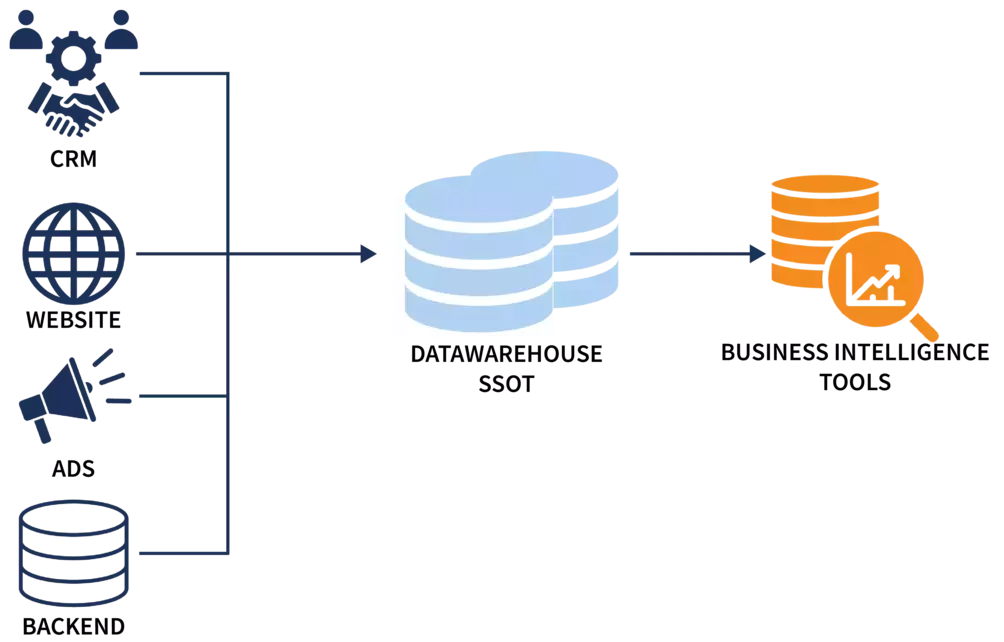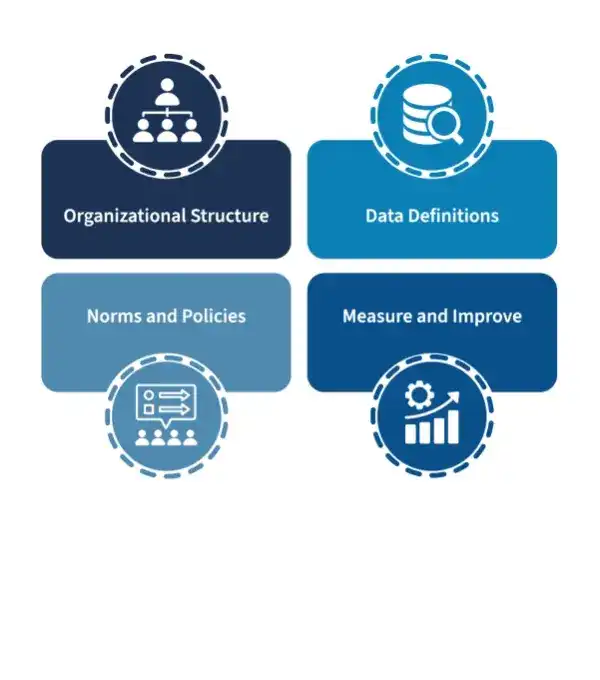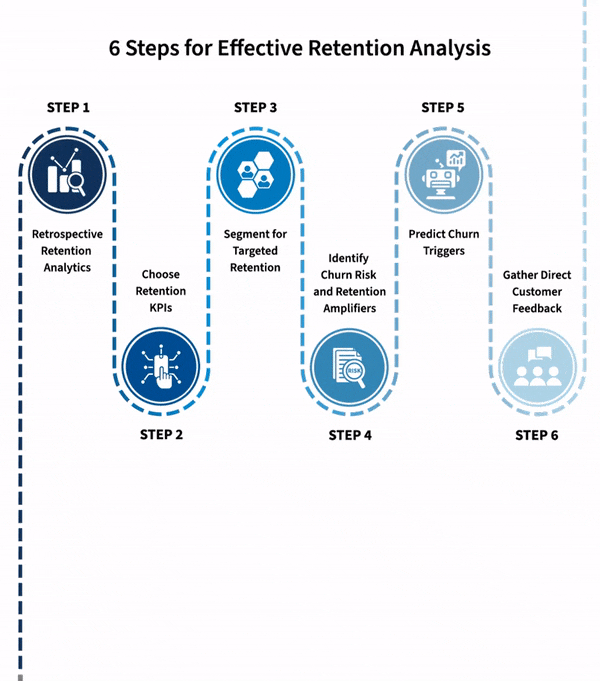
 Maximilian Filtenborg
Maximilian Filtenborg

Dive into data-driven marketing's role in B2B success. Master strategies, measure ROI, and personalize for impact. Explore what data-driven marketing is in our concise guide.
Nowadays, there are so many avenues to success that any company will use several marketing strategies. Multichannel is key.
With these advancements also come challenges: how do the different strategies, content marketing, email marketing, etc., fit into a whole? What is the return on investment on our ads spent per campaign and overall? Which customer segments respond the best to your various campaigns? Can we attribute our success? Answering questions like these is a key reason to consider employing data-driven marketing.
Some of these challenges can be answered by just one software tool, e.g., HubSpot or Google Analytics. However, many of these require a holistic approach to data-driven marketing and cannot be answered by looking at the data or dashboards of just one tool.
To excel, embrace data-driven marketing – an integral part of a modern marketing strategy. Leverage data to:
Continue reading to learn more about data-driven marketing and how to apply it to your business.
Data-driven marketing is not something you start with. However, if your marketing budget is growing and you want to maximize the potential and ROI of your marketing efforts, it is something you should consider as a business.
To read more about example success stories on data-driven marketing, this blog has some great examples.

Improve your ROI by making your marketing more personal.
When deploying marketing automation effectively, it’s crucial to remember that it isn’t only about making marketing more streamlined; it’s also about making it more effective by personalizing based on data. If a customer is a smaller business that cannot afford your enterprise package, don’t send them emails about it. This blog is not about the intricacies of personalized marketing, but sending a generic email to all your customers is rarely a good idea. Quality is key here.
The possibilities in marketing automation and segment analysis are endless, its important to keep it simple and effective. The fact is that everyone is being bombarded with more and more content every day. If your approach is very generic, you will be put in the same mental category as all the rest: spam. The advantages of implementing personalized marketing are substantiated by a McKinsey study, which reveals that personalized marketing can amplify ROI by a factor of 5 to 8.
Increase Marketing Efficiency through Data-Driven Insights
As a marketer, intuition and experience often play a significant role in decision-making. However, relying solely on these factors can be limiting. Data, on the other hand, always reveals the truth.
Your objectives and the corresponding Key Performance Indicators (KPIs) are paramount in data-driven marketing. They serve as the criteria by which you measure success and make necessary adjustments. Therefore, these goals must be clear and specific. This clarity makes it easier for you to align your marketing efforts and maintain a sharp focus. Limit the number of KPIs to the three most important objectives; this creates a clear focus and yields better results in practice.
To effectively leverage these KPIs, you need to be able to make your marketing measurable. This means you need insight into your product margins and marketing funnel. You can start measuring your success end-to-end and identify the key areas for improvement.
Improve your (Product) Offering by Understanding Customer Segments
Achieving better campaign performance begins with a keen analysis and precise targeting of your customers. This approach ensures you offer enterprise-level deals to your enterprise customers while tailoring smaller packages for your startup clientele. Thoroughly scrutinizing customer segments unveils opportunities where you might be missing out on potential revenue. It’s imperative to recognize that each customer has unique needs. Discovering and meeting these needs through data-driven insights will enable you to refine your offerings effectively.
Now that we’ve seen the benefits of data-driven marketing let us discuss how to start with it. Without making it too complicated, the five basic steps are the following:
More is possible once these basics are established, from business intelligence to advanced analytics and machine learning use cases.
As underlined in this blog post from Adverity, many companies and marketers face challenges employing a data-driven strategy. Below, we shed light on some of the main challenges in becoming data-driven in general but also in marketing:

Challenge #1 - Gathering the data
You’ll most likely have abundant data you could use already – however, it is not easy to work with this mostly isolated data. Your CRM, website analytics, e-commerce, advertising tools, ERP system, social media software, and other tools can provide insights into customer interactions, from their profile information to website usage to interactions with your product and advertisements.
Challenge #2 - Data Integration
The second challenge revolves around consolidating data into a singular repository. This undertaking demands a comprehensive and systematic approach that considers the entirety of the data landscape. Automation is crucial for success in this pursuit, underlining the importance of moving away from manual methods such as joining data in Excel spreadsheets.
Paramount in this step is to integrate the data so that it can also be utilized. Quality of the data and having all the required attributes to join different datasets is key.
Challenge #3 - Not starting with the end in mind
As with any IT project, getting bogged down in the details is a risk you must guard for. Start with a clear business case and a few data sources, and iterate week over week. A fast delivery time coupled with data-driven experiments is the best way to gain success in weeks instead of months or years.
As companies start using more and more tools for their marketing, they run into the problem that they don’t communicate so well. Having data in all these separate silos will limit you from automating and scaling. At some point, you will need a central brain for analysis.

A data warehouse is the solution, combining all these data sources into one database. You will, however, need a data pipeline to integrate all these data sources. You can find out more about that here. A modern data stack is an efficient way to build a data warehouse and pipeline with less effort, as much of the manual effort is forgone by using SaaS tools.
Some of the key benefits of having a marketing data warehouse:
Creating a data-driven marketing strategy is a vast topic, but below, we have tried to summarize it in the following six steps.

Step 1. Establish your goals and use cases.
The first step in creating a data-driven marketing strategy is to set the goals you want to achieve. Create clear objectives and data use cases, creating a clear goal for the data. Examples of objectives could be basing more decisions on data analysis or creating customer segments for targeted marketing campaigns based on different characteristics. These decisions will guide you in the next step, gathering the data requirements.
Step 2. Gather requirements & data
Analyze your objectives and data use cases, and identify the required information to employ your data-driven strategies. Think about what form the data will take and the points you need. Involve stakeholders from different teams to ensure the data you want to access is available.
Step 3. Create a data roadmap.
Create a data roadmap by deciding on an architecture for collecting, storing, and processing the data. Whether you choose a solution that streams your data in real-time for real-time insights or uses a Modern Data Stack that offers rapid development, create an architecture that will handle your current and future needs.
Step 4. Collect and organize the data.
Build out the data architecture and platform, collecting and organizing the data.
Step 5. Introduce a data-driven culture and set up reports.
Essential to successfully creating a data-driven strategy is to create a culture where everyone is up to date on the data and working with it daily. Crucial is to have tailor-made dashboards with actionable insights. Introduce KPIs and weekly reviews of the dashboards with your teams to ensure everyone is making decisions based on data.
Step 6. Measure and Improve. Given that you have established a data-driven approach leverage your new resources and gradually improve your outcomes by relying on data.
In the ever-evolving B2B marketing landscape, digital relationship management, smarter targeting, and personalized communication reign supreme. As companies navigate a maze of marketing strategies, multi-channel approaches are key to success. However, challenges loom: harmonizing diverse strategies, gauging comprehensive ad ROI, identifying responsive customer segments, and attributing success. Data-driven marketing is the key to solving these enigmas.
While some challenges can be addressed with tools like HubSpot or Google Analytics, many necessitate a holistic, data-driven approach that transcends individual tools. To excel, data-driven marketing must be integral to a modern strategy, empowering measurement and enhancement of marketing efficiency, personalization, and clear, measurable objectives.
Data-driven marketing isn’t where you start but rather a strategic progression for businesses, especially as budgets grow. It shines brightest for firms with abundant customer data, those aiming to scale marketing precisely, and those using diverse channels requiring a unified view.
Three pivotal reasons for data-driven marketing include increasing efficiency, infusing personalization, and enhancing campaign effectiveness.
The journey into data-driven marketing involves five phases, from harnessing first-party data to experimentation, laying the foundation for advanced endeavors like business intelligence and machine learning.
Yet, challenges persist. Gathering and integrating data, fostering a data-driven culture, and starting with a clear business case is critical. Amid these challenges, the marketing data warehouse emerges as a potent solution.
In summary, data-driven marketing isn’t just a strategy; it’s a transformative journey reshaping how businesses operate in a data-rich world. By harnessing data’s power, organizations can create personalized experiences, enhance campaigns, and unlock strategic insights. In today’s dynamic marketing landscape, data-driven marketing remains a beacon of progress and success.

Maximilian is a machine learning enthusiast, experienced software engineer, and co-founder of BiteStreams. In his free-time he listens to electronic music and is into photography.
Read moreEnjoyed reading this post? Check out our other articles.

 Maximilian Filtenborg
Maximilian Filtenborg

 Maximilian Filtenborg
Maximilian Filtenborg

 Maximilian Filtenborg
Maximilian Filtenborg